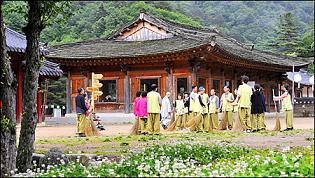
|
|
|
Home Asia Pacific North Asia S/N Korea Temple Stay Night at a Korean TempleBy Cathy Rose A. Garcia, Han Sang-hee, The Korea Times, July 3, 2008Baekdamsa , South Korea -- Spending a weekend at a temple is becoming increasingly popular these days, with more people seeking refuge from the noisy city to find peace of mind.
Baekdamsa, located in Mt. Seorak National Park, is one of the favorite venues for temple stay programs. Beautiful mountains and creeks surround the temple, which offers interesting programs. The Korea Times team traveled four hours by car from Seoul to Baekdamsa, braving the weekend traffic on the highways, intermittent rain showers and the winding roads leading to the temple.
The temple was first built in 647 and suffered numerous fires and reconstructions. The temple standing now was built in 1957. Many famous philosophers and monks visited and meditated at Baekdamsa, Han Yong-un (1879-1944) being one of them. A poet, independence fighter and a monk, Han studied and meditated at Baekdamsa. The temple is also known as the so-called ``exile'' of former President Chun Doo-hwan during the late 1980s. The standard temple stay program at Baekdamsa takes around 24 hours, starting at 1 p.m. on Saturday and ending on Sunday. The program starts with a brief introduction on the activities, such as ye-bool or Buddhist ceremonial service; cham-seon or Seon meditation; balwoo-gongyang or Buddhist meal with traditional bowls; dado or tea ceremony; and ulyeok or community work. At the beginning of the templestay, participants are given a tour of the temple and the nearby forest. Shim Kwang-seob from the Korea Environment Movement Center was one of the forest guides and he was more than eager to share his expertise on the trees and animals living around the temple. ``It's important to appreciate the surroundings. Nothing should be taken for granted. Because temples are mostly located in mountains, understanding the surroundings is also a part of the whole meditation process,'' he explained. Participants were also given a chance to play with the four temple treasures or ``dharma instruments,'' namely the gigantic bell, drum, cloud-shaped gong and moktak or wooden fish-shaped percussion instrument. ``It's all about your attitude. The four different instruments represent every living creature, even germs. So when you play them, you must be sincere and really mean it. It's not a game, but all part of a ritual of celebrating life,'' Ven. Samjo, the head monk of Baekdamsa, said before showing an example. For dinner, participants experienced the balwoo-gongyang, where each is given a set of four wooden bowls, chopsticks and spoon wrapped in cloth. Everyone had to sit in a lotus position and should not speak or make any noise, except for the special prayer. The balwoo signifies a precise amount of food that is needed for bodily sustenance and given to a person. Participants should only get the rice and food (mostly vegetables and kimchi) that they can eat, and not a grain of rice should remain in the bowls. At first, water is poured on the bowl and used to clean each of the bowls. Then, rice is placed on the biggest bowl, soup on the second bowl, kimchi and vegetables on the third bowl, while the last bowl is filled with water. A single piece of kimchi is dipped in the water, and placed in the rice bowl, but it is not to be eaten. After eating, the piece of kimchi is used to wipe the bowls clean. For someone new to the Buddhist meal, the process is difficult to follow because of all the specific rules. Monks believe that eating is a form of meditation, but for beginners the experience can be tedious and stressful because of the pressure not to leave a single morsel in your bowl. Everyone had to drink the same water used to clean the bowls. Fresh water is once again poured on the bowls for a final cleaning, and then collected in two big pails. The monk compared the water from the two pails, and the group with the dirtiest water was ``punished'' by having to drink a teaspoon of the ``dirty'' water. While it is important to be respectful of the Buddhist monks' way of life, this struck us as disgusting, not to mention unsanitary. One of the most important activities during the temple stay is the Seon meditation, which involves concentration with the aim of discovering one's true self. Seon is taken from the Sanskrit word ``dhyana,'' meaning contemplation and religious meditation. Two types of meditation, sitting meditation (jwa-seon) and walking meditation (haeng-seon), are introduced. The dado or tea ceremony may seem simple enough, but it is not just about drinking tea. The act of brewing and drinking the tea involves practicing Buddha's teaching of ``proper mindfulness and concentration.'' There is even a Buddhist saying ``da-seon-il-me,'' meaning tea and Seon taste the same. Ye-bool is a Buddhist temple ritual that involves giving respect to Sakyamuni Buddha and his disciples, and is performed three times a day, at 3 a.m., 11 a.m. and 6 p.m. The pre-dawn ceremonial service begins at around 2:40 a.m. when the sound of the moktak awakens the residents. Having barely slept four hours, we woke up groggy and hungry. At 3 a.m., the ceremony begins when everyone re-enters the temple grounds with handmade candles and walk to the main hall. Inside the main hall, they bowed three times before the Buddha Altar, Guardians' Altar and Memorial Altar, while the monks chanted Buddhist prayers. Listening to the chanting at the break of dawn was like an otherworldly experience. Perhaps one of the most difficult aspects (aside from waking up at 3 a.m.) is the 108 bows. This is part of the Buddhist belief that mankind goes through 108 periods of anguish in life, and should make the 108 bows to be free from this anguish. It is considered a good meditation practice. But this reporter (Han) confesses to stopping mid-way; it was physically rigorous. After breakfast, everyone takes part in the ``ulyeok'' or community work such as sweeping the grounds or cleaning the halls. Work is seen as a way of practicing Buddhism by cultivating patience and discipline. There is a Korean Seon rule that states: ``a day without work is a day without food.'' ``I think temple stay programs are the only way to fully experience and understand Buddhism. It's so different from reading a book or watching a video. The peace, the nature and the meditation stay with you even when you go back to your daily routine in the city. Whenever I feel tired or frustrated, I try to remember my experience in the temples. I think it helps me live a more slow-paced and peaceful lifestyle,'' Kim Yong-sam, the director of the traditional arts division at the Ministry of Culture, Sports and Tourism and a fellow participant, said. Throughout the different activities, the monks explain the Buddhist philosophy and lifestyle, and guide the participants. However, foreigners should make sure to ask if the temples offer English interpretation services, or else it would be difficult and uncomfortable to follow the lectures and activities. |
 |
|
| Korean Buddhist News from BTN (Korean Language) |
|
 |
|
|
Please help keep the Buddhist Channel going |
|
| Point
your feed reader to this location |
|

 Many temples now offer weekend-stay programs, luring Koreans, foreign tourists and expatriates who want to experience the life of Buddhist monks at their picturesque sites dotted around Korea.
Many temples now offer weekend-stay programs, luring Koreans, foreign tourists and expatriates who want to experience the life of Buddhist monks at their picturesque sites dotted around Korea. 

